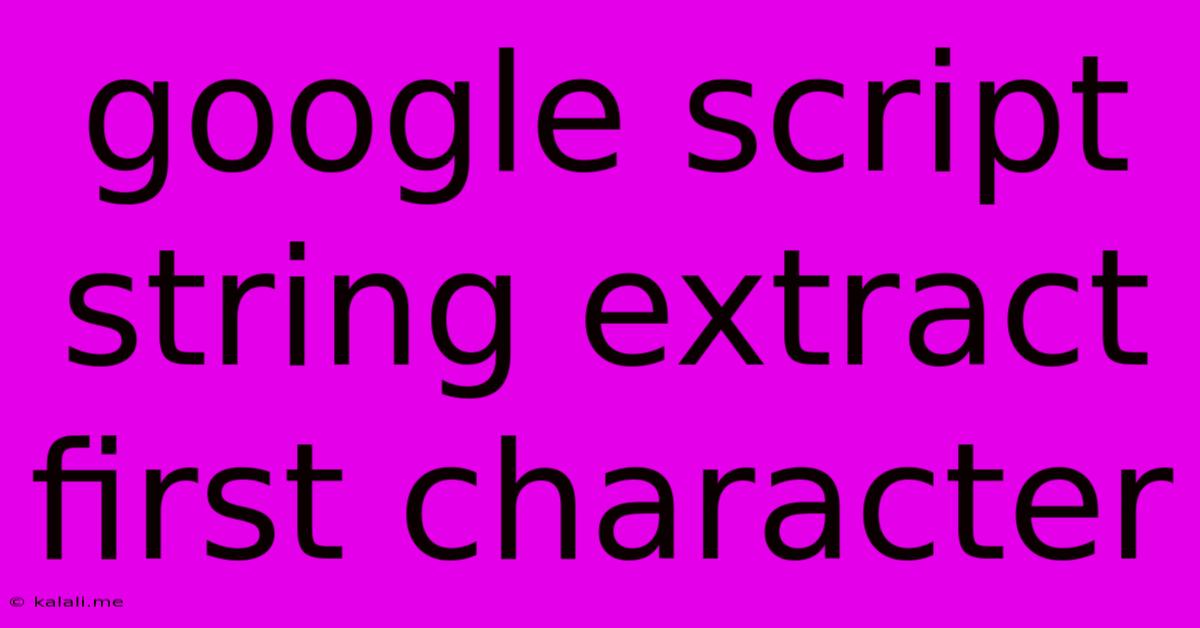Google Script String Extract First Character
Kalali
Jun 06, 2025 · 3 min read

Table of Contents
Extracting the First Character of a String in Google Apps Script
This article will guide you through several methods for extracting the first character of a string within Google Apps Script, a powerful scripting language for automating tasks within the Google Workspace ecosystem. Whether you're working with spreadsheets, forms, or other Google services, efficiently manipulating strings is a common requirement. This guide provides various approaches, catering to different levels of experience and specific needs. Understanding these methods will significantly enhance your Google Apps Script capabilities.
Understanding the Problem and its Solutions
The core challenge lies in isolating the very first character from a longer string. While seemingly simple, there are multiple ways to achieve this in Google Apps Script, each with its own advantages and nuances. We'll explore using built-in string manipulation functions and alternative approaches for robustness and error handling.
Method 1: Using substring()
The substring() method is a straightforward and widely used approach. It allows you to extract a portion of a string, starting from a specified index. To get the first character, we simply start at index 0 (the first character's position):
function getFirstCharacterSubstring(str) {
if (str && str.length > 0) { //Check if the string exists and has content
return str.substring(0, 1);
} else {
return ""; //Handle empty or null strings
}
}
//Example usage:
let myString = "Hello World";
let firstChar = getFirstCharacterSubstring(myString);
Logger.log(firstChar); // Output: H
This method is concise and efficient for most scenarios. The added if statement ensures that the script gracefully handles empty or null strings, preventing errors.
Method 2: Using charAt()
The charAt() method provides a more direct way to access a specific character by its index. For the first character, we use index 0:
function getFirstCharacterCharAt(str) {
if (str && str.length > 0) {
return str.charAt(0);
} else {
return "";
}
}
//Example usage:
let myString = "Goodbye";
let firstChar = getFirstCharacterCharAt(myString);
Logger.log(firstChar); // Output: G
charAt() is arguably more readable and arguably slightly faster than substring() for this specific task, making it a strong contender. Again, error handling is crucial for robust code.
Method 3: Regular Expressions (for more complex scenarios)
While overkill for simply extracting the first character, regular expressions offer flexibility for more intricate string manipulations. If your needs expand beyond simply grabbing the first character, understanding this approach will be invaluable:
function getFirstCharacterRegex(str) {
if (str) {
let match = str.match(/^./); // Matches the first character at the beginning of the string
return match ? match[0] : "";
} else {
return "";
}
}
//Example usage:
let myString = "Programming";
let firstChar = getFirstCharacterRegex(myString);
Logger.log(firstChar); //Output: P
This uses a regular expression ^. to match the first character (. matches any character, ^ anchors it to the beginning). This approach becomes powerful when dealing with more complex pattern matching.
Choosing the Right Method
For simply extracting the first character, charAt() offers a concise and efficient solution. substring() is a viable alternative, and both methods benefit from explicit null and empty string handling. Regular expressions are best reserved for scenarios requiring more sophisticated string parsing. Remember to always prioritize robust error handling in your Google Apps Script projects to prevent unexpected behavior. This ensures your scripts are reliable and maintainable.
Latest Posts
Latest Posts
-
Twitter Website Page Keep Resfreshing Cannot Sign In
Jun 07, 2025
-
Is It Hard To Knock Down Stone Walls Interior
Jun 07, 2025
-
Someone Called Me And Told Me My Check Routing Number
Jun 07, 2025
-
Bathroom Exhaust Fan Not Strong Enough
Jun 07, 2025
-
How Do You Test The Spirits
Jun 07, 2025
Related Post
Thank you for visiting our website which covers about Google Script String Extract First Character . We hope the information provided has been useful to you. Feel free to contact us if you have any questions or need further assistance. See you next time and don't miss to bookmark.